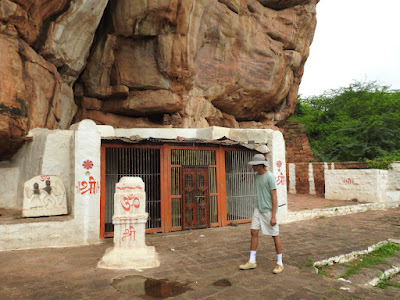Inside an Indian fort there has to be at least one idol of Anjaneya, the god of strength. Some forts have more than one shrine dedicated to Anjaneya. Inside the northern fort of Badami there are two shrines as I know, one each in the two routes to the summit. The two routes can be called eastern route and western route. The eastern route starts next Tattukoti temple group which also happens to be the starting point of Badami-Mahakoota footpath. 250 meters into the path, there's a staircase on the left hand side which goes straight to Anjaneya Gudi. That's Karun looking at the sandstone tower, at its base is the shrine.
Anjaneya's idol is carved on the rock itself and this structure has been erected to give shelter to the idol and people conducting pooja here. That's Karun son Mahottam walking across to join his father & sister who were checking our another shelter on our left.
Leaning on the wall is an ancient sculpture depicting a couple. The man is holding a bow, he must be an archer, and the woman must be his wife or lover. The sculpture seems to be a memorial honoring the memory of the warrior archer who might've lost life trying to protect this shrine.
That's Anjaneya's rock-cut image. Also there's a smaller idol placed in the corner. This shrine has been renovated recently, maybe a year or two ago. Normally Kannada text is seen in Karnataka however we have Devanagari text here. Probably the renovation was funded by a Hindi speaking group, like the group who look after Anjana Mandir on Anjanadri Betta near Anegundi.
This place is usually deserted hence it is peaceful. Tourists rarely come here, mostly local people come here on Saturday's or Tuesdays. We noticed this oil-paint sketches next to the temple, surely the work of an artist. Maybe the same artist who painted the texts in the temple. The sketches depict Sun & Moon, a line of humanoid figurines, a matrix of dots, and a human figure seemingly a woman wearing jewelry.
I found this particular set interesting. A column of eight men heading towards the viewer. The artist has a great sense of perspective.
Before closing this post, let's take a look at the Anjaneya idol which can be seen when you take the western path. That path starts next to the museum. That too is a rock-cut image. Besides the image there are two sets of Kannada inscriptions here.
Om Namo Anjaneyam.


















No comments:
Post a Comment